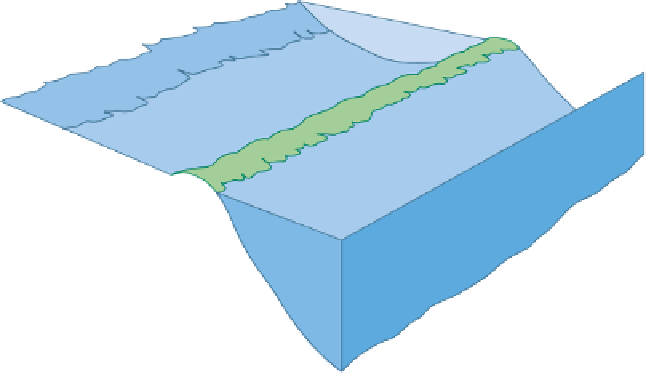Geology Reference
In-Depth Information
environment. Analogous features
can be observed on the present-day
Bahama Banks. In addition, numerous
small organic reefs occurred through-
out the craton during the Mississip-
pian. These were all much smaller than
the large barrier-reef complexes that
dominated the earlier Paleozoic seas.
During the Late Mississippian
regression of the Kaskaskia Sea from the
craton, vast quantities of detrital sedi-
ments replaced carbonate deposition.
The resulting sandstones, particularly
in the Illinois Basin, have been studied
in great detail because they are excel-
lent petroleum reservoirs. Before the
end of the Mississippian, the Kaskaskia
Sea had retreated to the craton margin,
once again exposing the craton to wide-
spread weathering and erosion resulting
in a craton-wide unconformity at the
end of the Kaskaskia Sequence.
Evaporation produces
a dense brine that sinks
and forms a thick
evaporite deposit
Inflow of seawater
replenishes water
lost by evaporation
SEQUENCE
The
Absaroka Sequence
includes rocks
deposited during the Pennsylvanian
through Early Jurassic. In this chapter,
however, we are concerned only with
the Paleozoic rocks of the Absaroka Sequence. The exten-
sive unconformity separating the Kaskaskia and Absaroka
sequences essentially divides the strata into the North Amer-
ican Mississippian and Pennsylvania systems. These two
systems are equivalent to the European Lower and Upper
Carboniferous systems, respectively. The rocks of the Absa-
roka Sequence not only differ from those of the Kaskaskia
Sequence, but also resulted from different tectonic regimes.
The lowermost sediments of the Absaroka Sequence
are confined to the margins of the craton. These depos-
its are generally thickest in the east and southeast, near
the emerging highlands of the Appalachian and Ouachita
mobile belts, and thin westward onto the craton. The
rocks also reveal lateral changes from nonmarine detrital
rocks and coals in the east, through transitional marine-
nonmarine beds, to largely marine detrital rocks and lime-
stones farther west (
Shallow sill impedes
the outflow of dense
brine from the basin
◗
Figure 20.12
Evaporite Sedimentation Silled basin model for evaporite sedimentation
by direct precipitation from seawater. Vertical scale is greatly exaggerated.
Although the origin of these extensive black shales is
still being debated, the essential features required to pro-
duce them include undisturbed anaerobic bottom water,
a reduced supply of coarser detrital sediment, and high
organic productivity in the overlying oxygenated waters.
High productivity in the surface waters leads to a shower
of organic material, which decomposes on the undis-
turbed seafloor and depletes the dissolved oxygen at the
sediment-water interface.
The wide extent of such apparently shallow-water black
shales in North America remains puzzling. Nonetheless,
these shales are rich in uranium and are an important source
rock of oil and gas in the Appalachian region.
Carbonate Deposition
Following deposition of the widespread Upper Devonian-
Lower Mississippian black shales, carbonate sedimentation
on the craton dominated the remainder of the Mississip-
pian Period (
◗
Figure 20.17).
Are They Important?
One characteristic feature of Pennsylvanian rocks is their
cyclical pattern of alternating marine and nonmarine strata.
Such rhythmically repetitive sedimentary sequences are
called
cyclothems
. They result from repeated alternations
of marine and nonmarine environments, usually in areas of
low relief. Although seemingly simple, cyclothems refl ect a
◗
Figure 20.16). During this time, a variety of
carbonate sediments were deposited in the epeiric sea, as
indicated by the extensive deposits of crinoidal limestones
(rich in crinoid fragments), oolitic limestones, and vari-
ous other limestones and dolostones. These Mississippian
carbonates display cross-bedding, ripple marks, and well-
sorted fossil fragments, all of which indicate a shallow-water












Search WWH ::

Custom Search